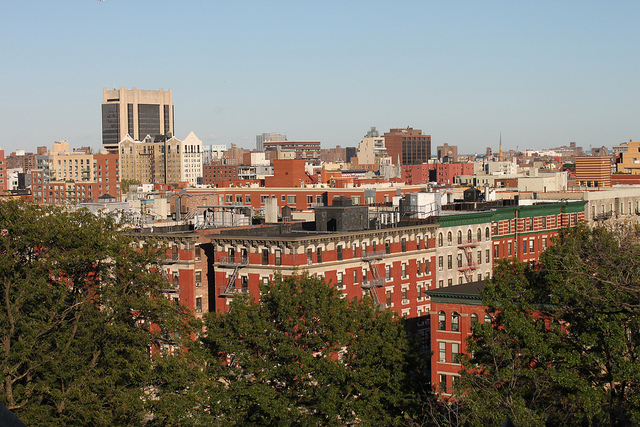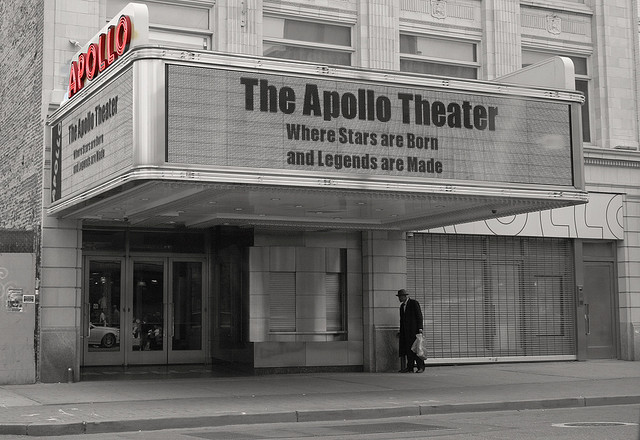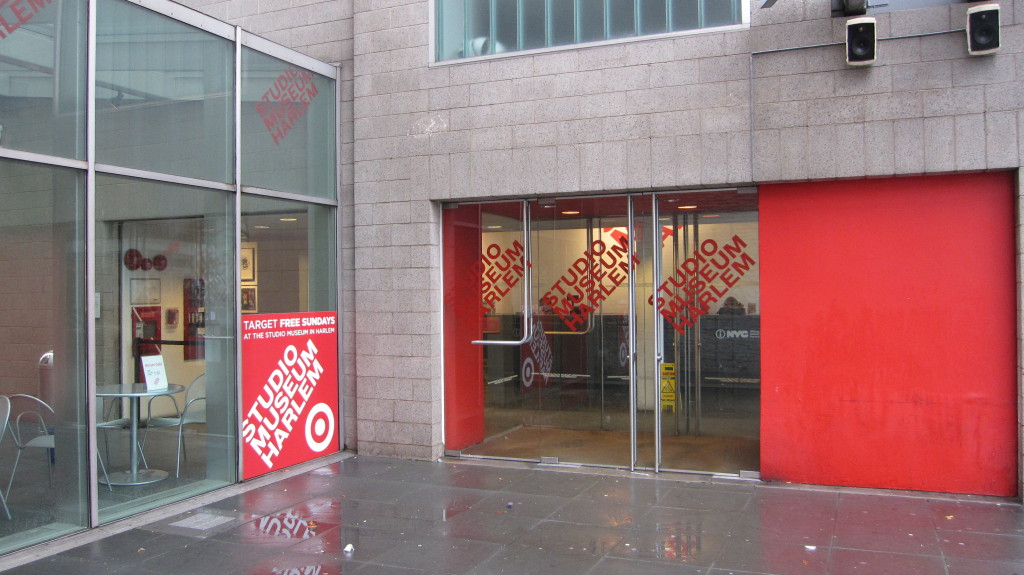Known for its 400 churches, elegant row houses, scrumptious soul food, and multiple parks, Harlem is becoming a top destination for anyone visiting Manhattan, as well as those who live here, drawing people uptown from downtown for an evening out.

Central Harlem (Photo: Joseph via Flickr)
When my husband and I moved to Harlem a few months ago, we were drawn in by the location just above Central Park, the amazing brownstones, and the friendly vibe. After exploring the area throughout the summer, I’m inspired by its history and intrigued by its culture, as Central Harlem is experiencing a resurgence of creativity and commerce. New galleries, upmarket restaurants, music halls and lounges are opening alongside the venues for which Harlem has long been famous.
Known for its 400 churches, elegant row houses, scrumptious soul food, and multiple parks, Harlem is already a top tourist destination for Europeans, and is an increasingly popular stop for anyone visiting Manhattan, as well as those who live here, coming uptown from downtown for an evening out. Although this quintessential New York neighborhood has been cleaned up, it retains its character and is sometimes reminiscent of the seventies—where you can still see kids playing in fountains spewing from fire hydrants, hear music blasting in the streets, and see families sitting on their front stoops barbecuing on the sidewalk.
A historic and iconic neighborhood
To understand and appreciate the Harlem of today you must delve into its rich history and the battles its inhabitants have fought—from defeating the British in the Revolutionary War to overcoming poverty and oppression to victories in the Civil Rights movement.
Founded in 1658 by the Dutch, for a couple of centuries the area was mostly farmland dotted with luxurious estates. In 1776 at the Battle of Harlem Heights, Washington experienced his first American victory in the Revolutionary War at what is now West 125th Street, driving out twice as many British troops—who in revenge returned to burn Harlem to the ground.
Rebuilding took decades and the village remained rural yet wealthy. By 1876 row houses were constructed in large numbers as early entrepreneurs had grandiose plans for Harlem. At the turn of the century the resulting glut of housing led to a crash in values. Following the Eastern European Jews and then the Italians, a mass migration of Blacks began to move into Harlem.
The expansion was further fueled by an influx of African Americans from the Southern states as well as immigrants from the West Indies, leading to the Harlem Renaissance, an outpouring of artistic work without precedent in the black community, which extended to poetry, novels, theater, music and the visual arts. In the roaring twenties Harlem hit its heyday, with no less than 125 entertainment establishments on the block between Lenox and Seventh Avenue—where the Apollo still stands today—including speakeasies, lounges, cafes, taverns, supper clubs, rib joints, and dance halls, their grand marquis fighting for attention.

The Apollo Theater, Harlem. (Photo: Dr. Wendy Longo via Flickr)
The neighborhood was hit hard by the Great Depression and continued its decline until the 1970s, unarguably the worst period in Harlem’s history. However, since the late nineties, Harlem has been on the rise, thriving and gentrifying while holding on tight to its roots.
Today the history can be seen in its architecture and landmarked buildings, including many well-preserved brownstones and churches as well as a handful of venues still in operation, reminding one of a more opulent era. A walking tour is a good place to start. We recommend Harlem One Stop cultural walking tours, a 90-minute stroll that covers Revolutionary War sites, historic mansions, row houses, churches, the Apollo and the new restaurant row. Led by licensed tour guides who are also long-time residents, One Stop also offers Hallelujah! Gospel Wednesdays, a Music Culture Tour, and walks that focus on specific neighborhoods within Harlem such as Hamilton Heights and Sugar Hill. Many companies offer Sunday gospel choir church tours, which often include a soul food brunch.
Rich in Culture and Cuisine
In the afternoon, art and music lovers should visit a couple of Harlem’s acclaimed museums. Founded in 1968, Studio Museum Harlem has earned global recognition for its well-curated exhibits and catalytic role in promoting the works of artists of African descent, as well as art inspired and influenced by black culture.

The Studio Museum in Harlem
The National Jazz Museum in East Harlem houses small exhibits but is more focused on the audio than the visual with its vast library and extensive CD and DVD archive. Although the museum attracts jazz aficionados, their main mission is to make jazz approachable and available, offering excellent programming that is free and open to all, including the popular Jazz For Curious Listeners on Tuesday evenings.
Foodies can feast in Harlem, from traditional soul food restaurants such as Sylvia’s to the Red Rooster next door, run by world renowned Chef Samuelson, who serves fusion southern food that pays homage to his Scandinavian roots. For the best burger—or a jerk chicken sandwich that will titillate your taste buds—go to Harlem Shake, a bustling 1940s-style diner. Maison is our favorite brunch spot, serving French artisanal food with plenty of flavor. We recommend Cheri for dinner, the newly opened restaurant in the ground floor of a brownstone, complete with a fireplace, grand piano, cozy sofas, and an outdoor garden; the homey ambiance and three course set menu each night makes you feel as if you’ve been invited to a private dinner party. There is no shortage of fine dining to choose from in the neighborhood with upscale restaurants and wine bars beckoning all up and down Frederick Douglas Boulevard.
The Hottest Sounds in the City
Evenings really heat up in Harlem and can be jam-packed with live music. Catch a show at the world-famous Apollo. Amateur Night is on Wednesdays, and the talent contest that’s been continually running for over 70 years is sure to impress. Ginny’s Supper Club in the basement of the Red Rooster is quite the scene for jazz and jet setters alike; the gorgeous crowd is glammed up and glitzed out. For a more mellow vibe, hit Paris Blues, an old school lounge that’s been in operation since 1969, where freestyle jam sessions attract a diverse, quirky clientele ranging from locals to luminaries. Free soul food is served up along with soulful blues and jazz each night until the wee hours.
Twelve blocks north, The Shrine World Music Venue is hidden behind an old deli awning that might easily be missed, but once inside you are transported to what could be Jamaica, Africa, or Detroit—depending on the music—with a smoky ambiance and old albums plastering the wall. The live music covers a wide spectrum includig reggae, hip hop, blues, indie, folk, funk, Latin beats, rock, rap, big band, neo soul, psychedelic, even country, with four or five bands booked per night.
The hardest thing about Harlem is choosing how to spend limited time, so why not stay a while? Slightly more affordable than downtown, it’s a great place to base your trip with access to three major subway stations and six express lines. Book a room in one of the many Bed & Breakfasts in historic brownstones or one of the recently opened boutique hotels. Experience the tastes, sights and sounds of Harlem, a neighborhood as spirited and colorful as the bright suits and patterned head wraps still worn with style by its residents.